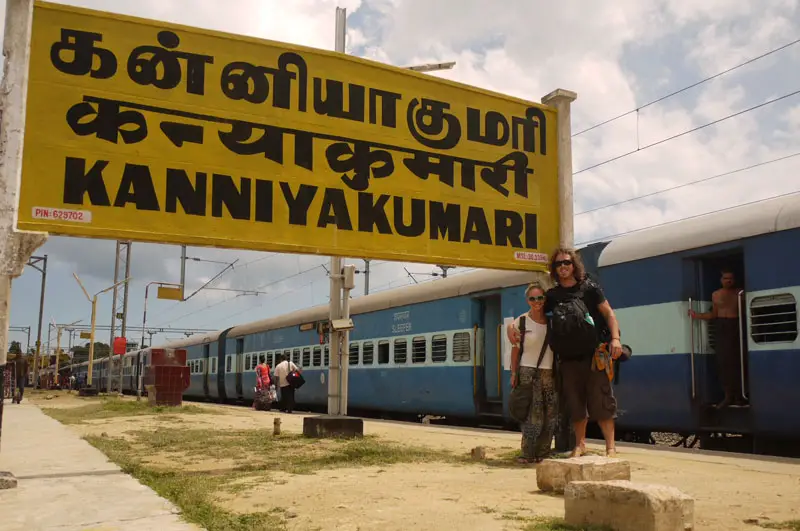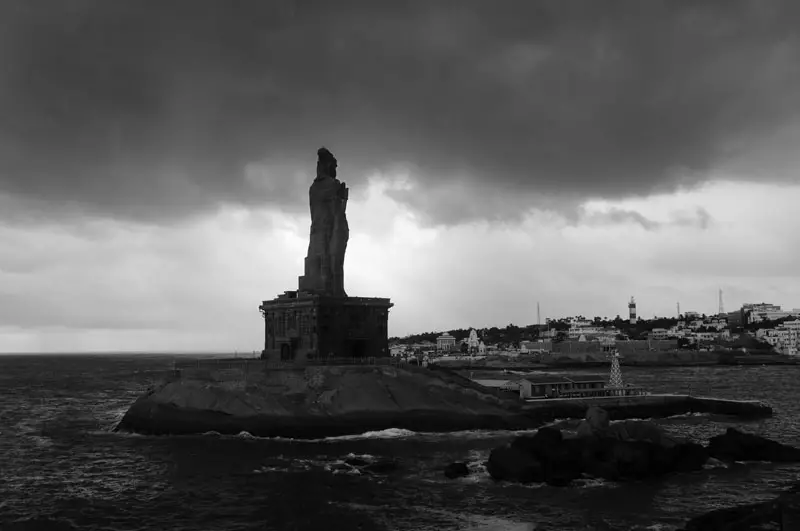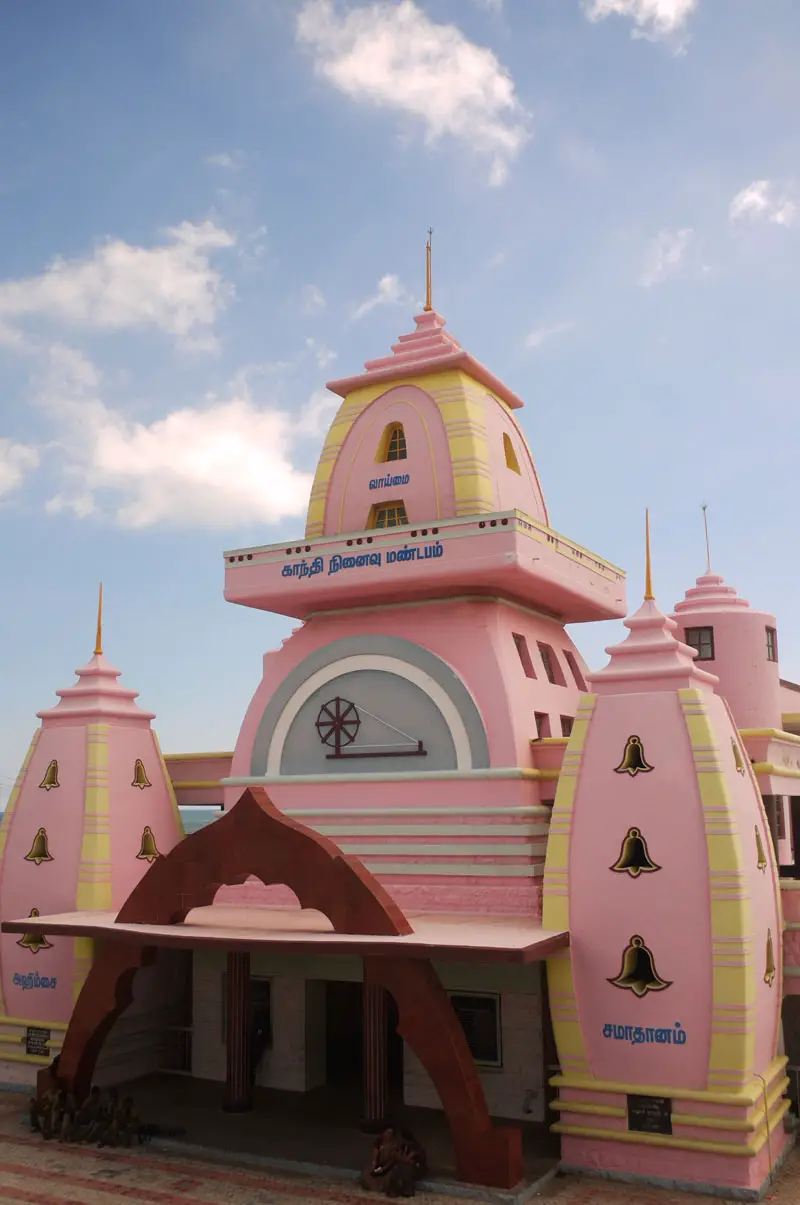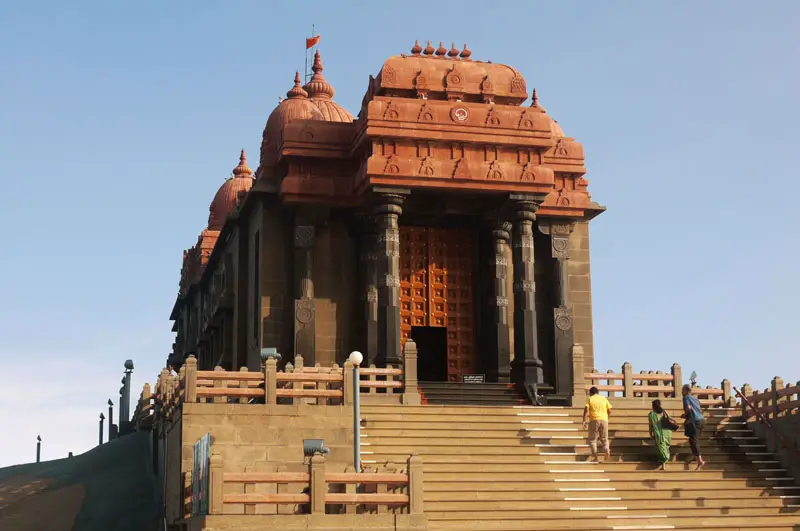India’s southern most point, Kanyakumari or Cape Comorin as it’s also known, is a special place for Indian’s and foreign visitors alike. For Indian visitors the end of the road is marked by a number of memorials, temples and shrines which are of equal interest to the many foreigners who make it this far to stare across the open ocean. Three seas meet at this point, the Arabian Sea, the Lakshadweep Sea and the Indian Ocean and being here on these holy shores, there’s a real sense of accomplishment at making it here. It’s an unusual sight in India to hop off the train and pass the railhead marking the end of the rail line as they usually continue for hundreds of miles criss crossing across the nation.
Through the bazaar selling all the usual tourist tack and more polished conch shells than one man could know what to do with we headed straight for the ferry to the islands which lie only four hundred metres off shore.
Swami Vivekananda, a Kolkata local, travelled all over India and was deeply moved to see the incredible poverty which the Indian masses lived in. He declared that the real cause of India’s problems was the neglect of the masses and developed teachings around the concept of social justice. Meditating on this rock Vivekananda decided to take his teachings beyond India to America and England. As a ‘messenger of Indian wisdom to the Western world’, the Swami Vivekananda, spent almost three and a half years spreading his teachings in America and London. Getting off the ferry on this same rock, there is now a beautiful memorial to Vivekananda built in 1970. Towering over the memorial on the smaller island right next door is the work of more than five thousand sculptors, the ‘Indian Statue of Liberty’, a forty metre tall statue of the Tamil poet, Thiruvalluvar.
Back on the mainland we skirted around the tip of the peninsula checking out the various monuments and memorials which line the southern most point of the country.
A gaudy pink building displaying architectural traits of the Hindu, Christian and Muslim religions marks the Gandhi Memorial and on Gandhi’s birthday each year the sun shines on the stone where some of his ashes were once stored. Working east you will pass a small memorial to Kamaraj, the ‘Ghandi of the south’, who was one of the most influential politicians after India got it’s independence. A little railed garden contains a wave shaped memorial dedicated to those who lost their lives in the 2004 tsunami. Here the seafront comes to a point where everyone gathers to watch the sunset and the sunrise the next morning. A semi-submerged Lingam lies in amongst the rock pools and Indian tour groups and families happily swim and play in the water fully clothed as they wait for the sun to go down.
Kumari Amman Temple was to be our final stop before collecting our bags and heading back to the station to take the night train to the Varanasi of the South, Rameswaram and it was a great way to finish up our time in
Kanyakumari. Men have to be bare-chested going into this temple, dedicated to the Hindu goddess, Kumari who single-handedly conquered demons and brought freedom to the world. We were led around the temple by one of the priests and walked through each and every one of the customs and rituals which the locals were performing inside the colourful walls of the temples. With candles casting an eerie glow on deities in different alcoves and pilgrims going about their prayers with real devotion it was a lovely experience inside the sacred grounds but with our train departure time coming closer it was time to leave the temple and Kanyakumari and make our way to India’s other famous southerly point, Ramesawram, a seven hour train ride east.

Brian is a travel writer, photographer, blogger, travel addict and adventure-junkie. Being outdoors, getting off the beaten track and outside his comfort zone is what makes him tick. Brian’s the dreamer in the relationship; when he’s not travelling, he’s dreaming about it! Keeping fit, cooking, music and red wine take up the rest of his time.
Sign up for our free travel photography Ebook "Faces of Nepal" and you'll also receive our monthly newsletter.








